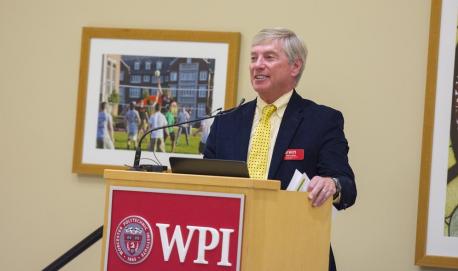
For undergraduate instruction, I enjoy relating the fundamentals of individual material properties and biological processes to the engineering of complex systems or processes to produce medically useful products. Coupling engineering principles with the inherent challenges of biological systems to understand and predict system behavior in the context of the capstone design experience is of particular interest. I currently consult for several companies in the area of development of cell and engineered tissue based therapeutic product development and genetic diagnostics. Where appropriate, I relay these experiences to both undergraduate and graduate students to bring current activities and challenges facing the industry into their educational experience. I also enjoy participating in training and mentoring programs involving undergraduates from peer institutions and secondary education teachers to help bring current biotechnological concepts into their curriculum. For research, understanding the interplay between cells and their environment with respect to growth factor/cytokine signaling is becoming a powerful tool with which to control cell phenotype and has applications in regenerative medicine and wound healing. In our lab we study the effects of ambient oxygen tension and cell culture substrate on the effect of specific growth factors in determining the growth rate, state of differentiation, and regeneration potential of primary human cells. Environment-induced alterations of cell phenotype are studied in skeletal muscle wound models. We are also interested in the development of three-dimensional in vitro models of skeletal muscle formation and function. We have employed novel biopolymer microthread technologies developed in the BME Department to deliver these cells in vivo to study their regeneration potential. In addition, we also study the effect of cell culture environment and substrate related to the control of cell phenotype and stem cell differentiation using primary adult cells derived tissues such as bone marrow, skin, and skeletal muscle. At the graduate level, I strive to create an environment where students are free to explore and develop their own independent ideas and concepts related to the overall research objectives. I encourage active collaboration and interaction with fellow colleagues involving diverse disciplines.

For undergraduate instruction, I enjoy relating the fundamentals of individual material properties and biological processes to the engineering of complex systems or processes to produce medically useful products. Coupling engineering principles with the inherent challenges of biological systems to understand and predict system behavior in the context of the capstone design experience is of particular interest. I currently consult for several companies in the area of development of cell and engineered tissue based therapeutic product development and genetic diagnostics. Where appropriate, I relay these experiences to both undergraduate and graduate students to bring current activities and challenges facing the industry into their educational experience. I also enjoy participating in training and mentoring programs involving undergraduates from peer institutions and secondary education teachers to help bring current biotechnological concepts into their curriculum. For research, understanding the interplay between cells and their environment with respect to growth factor/cytokine signaling is becoming a powerful tool with which to control cell phenotype and has applications in regenerative medicine and wound healing. In our lab we study the effects of ambient oxygen tension and cell culture substrate on the effect of specific growth factors in determining the growth rate, state of differentiation, and regeneration potential of primary human cells. Environment-induced alterations of cell phenotype are studied in skeletal muscle wound models. We are also interested in the development of three-dimensional in vitro models of skeletal muscle formation and function. We have employed novel biopolymer microthread technologies developed in the BME Department to deliver these cells in vivo to study their regeneration potential. In addition, we also study the effect of cell culture environment and substrate related to the control of cell phenotype and stem cell differentiation using primary adult cells derived tissues such as bone marrow, skin, and skeletal muscle. At the graduate level, I strive to create an environment where students are free to explore and develop their own independent ideas and concepts related to the overall research objectives. I encourage active collaboration and interaction with fellow colleagues involving diverse disciplines.
Scholarly Work
Rapid release of growth factors regenerates force output in volumetric muscle loss injuries. Grasman JM, Do DM, Page RL, Pins GD. Biomaterials. 2015 Dec;72:49-60. doi: 10.1016/j.biomaterials.2015.08.047. Epub 2015 Aug 28. PMID: 26344363
Biomimetic scaffolds for regeneration of volumetric muscle loss in skeletal muscle injuries. Grasman JM, Zayas MJ, Page RL, Pins GD. Acta Biomater. 2015 Oct;25:2-15. doi: 10.1016/j.actbio.2015.07.038. Epub 2015 Jul 26. Review. PMID: 26219862
Maintenance of multipotency in human dermal fibroblasts treated with Xenopus laevis egg extract requires exogenous fibroblast growth factor-2. Kole D, Ambady S, Page RL, Dominko T. Cell Reprogram. 2014 Feb;16(1):18-28. doi: 10.1089/cell.2013.0066. Epub 2014 Jan 3. PMID: 24405062
The hazards of DAPI photoconversion: effects of dye, mounting media and fixative, and how to minimize the problem. Jež M, Bas T, Veber M, Košir A, Dominko T, Page R, Rožman P. Histochem Cell Biol. 2013 Jan;139(1):195-204. doi: 10.1007/s00418-012-1039-8. Epub 2012 Oct 14. PMID: 23064788
Restoration of skeletal muscle defects with adult human cells delivered on fibrin microthreads. Page RL, Malcuit C, Vilner L, Vojtic I, Shaw S, Hedblom E, Hu J, Pins GD, Rolle MW, Dominko T. Tissue Eng Part A. 2011 Nov;17(21-22):2629-40. doi: 10.1089/ten.TEA.2011.0024. Epub 2011 Aug 2. PMID: 2169941
Expression of NANOG and NANOGP8 in a variety of undifferentiated and differentiated human cells. Ambady S, Malcuit C, Kashpur O, Kole D, Holmes WF, Hedblom E, Page RL, Dominko T. Int J Dev Biol. 2010;54(11-12):1743-54. doi: 10.1387/ijdb.103192sa. PMID: 21136380
